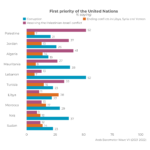Promoting productive employment opportunities dominates policy agendas around the world, particularly in the YEM Partner Countries. This is not surprising considering the demographic trends in these countries where a big – and expanding – share of the national populations is under the age of 25. As a substantial majority of the population approaches working age, there is a critical need to ensure that productive livelihood opportunities and an enabling environment for human capital optimization exists.
![]() Yet, the current situation on the employment front does not look that encouraging. While unemployment levels across the working age groups remain high, the worst affected segment of the population is the youth. Unemployed youth are the highest in Palestine (45%), Libya (42%), Jordan (36.6%) and Tunisia (34.8%), while Morocco (21.9%) and Lebanon (17.6%) fare relatively better. Viewing this together with the share of share of the youth that is not in education, employment or training (NEET), reveals how the challenges of youth employment remain self-compounding. The youth NEET rates tally around 14% in Lebanon and 21% for Algeria, but progressively increase across Tunisia (25%), Jordan (28%), Morocco (28%), and Palestine (33%).
Yet, the current situation on the employment front does not look that encouraging. While unemployment levels across the working age groups remain high, the worst affected segment of the population is the youth. Unemployed youth are the highest in Palestine (45%), Libya (42%), Jordan (36.6%) and Tunisia (34.8%), while Morocco (21.9%) and Lebanon (17.6%) fare relatively better. Viewing this together with the share of share of the youth that is not in education, employment or training (NEET), reveals how the challenges of youth employment remain self-compounding. The youth NEET rates tally around 14% in Lebanon and 21% for Algeria, but progressively increase across Tunisia (25%), Jordan (28%), Morocco (28%), and Palestine (33%).
The International Monetary Fund cites among the key factors for youth unemployment and the lack of opportunities a severe skills mismatch between the needs of the local economies and the knowledge supplied by both the general and the TVET educational systems. In particular, the issue lies with the inability of the economy to create highly skilled workforce, curricula that are not adapted to private sector’s needs and an overall lack of labor market orientation of the educational systems.
At the same time, the sectoral distribution of the national economies in the YEM Countries are skewed towards the public sector. In the absence of a vibrant private sector and economic diversification, public sectors remain the main sources of employment . While the public wage bills increase as a percentage of the GDP, the marginal contribution to the GDP remains limited.
Taking into consideration the demographic development of these countries one can see how the mismatch between population growth and lack of employment opportunities could create significant spillover effects on local trends regarding work-related mobility and the desire to migrate. According to a 2017 Gallup Survey, the net brain gain remains negative for all the countries targeted by the YEM Project.
Data for the year 2019 from the Arab Barometer further outlines a significant increase compared to 2016 in the number of youth that considers to migrate. This trend is particularly strong in Jordan (+23%) and Morocco (+17%). Whereas the main reasons for Arab citizens to emigrate is predominantly economic, other commonly cited ones include corruption, security concern or to pursue further educational opportunities. The youth is significantly more likely to want to emigrate then older generations: 70% of the youth would like to leave the country in Morocco, 52% in Jordan, and 51% in Tunisia. Across the region, Europe is the most quoted destination, followed by the Gulf Cooperation Council country, the US, Canada, and non-GCC MENA countries…
This article was published on UNESCO-YEM Blog

